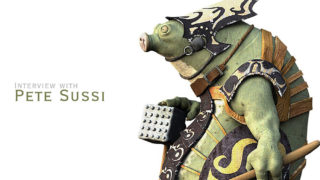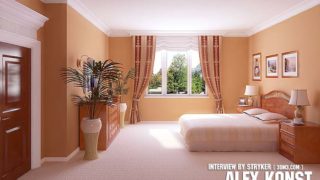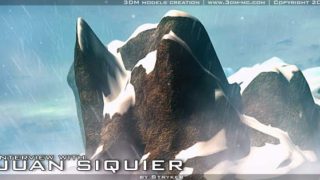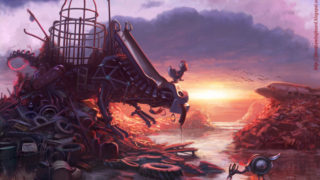
Interview with Tim Warnock
 |
||||
 |
A little bit about Tim Warnock: My name is Tim Warnock. I am a matte painter and conceptual artist working in the entertainment industry. TheNextSide represents a sampling of my most recent work. My career as an artist began in 1991 at St. Lawrence College in Ontario, Canada where I studied graphic design. While at St. Lawrence, it was my illustration classes that captivated my interest, so once I finished my studies I enrolled in the illustration program at Dawson College in Montreal. It was at Dawson that I developed a love for realism and was inspired by many of my talented instructors. Today my paint brushes sit neglected in a jar and my Wacom tablet receives much love. Digital media allows me to create and explore ideas faster and with greater freedom. The addition of 3D to my skill set has expanded my creative exploration into a new realm giving my work depth, dimension and motion. I am passionate about my craft and am driven to continually pursue quality and excellence in all aspects of my work. I hope you like what you see. Start to read Interview with Tim Warnock on next page…
|
 |
Education Illustration & Design – Dawson College, Graphic Design – St. Lawrence College, XSI 201 – NAD Center, Software Skills Photoshop, Painter, XSI, Illustrator, After Effects Work History Freelance Artist Senior Artist – SilverBirch Studios Designer / Illustrator – Riordon Design New Media Designer – iGroup Designer – The Panda Group |
 |
 |
||||
 |
Tell me about how you got started? Well I guess it all began as a kid. I always liked art and did well at it. Seeing my interest, my parents encouraged me in that direction. However, it has taken me a long time to find my niche. When I left high school I really didn’t realize how vast the art world was and it took me 10 years of trying different things to find what I really enjoy doing. How old were you when you became aware of such concepts as design and aesthetics? Not until my early 20’s I would say and those are things I am still learning about. There is so much to know! Before college I was really green. I just drew stuff like Conan and sports cars. They were terrible! I should dig up some of my pre-college work so people can see how far I’ve come. It’s incredibly bad! LOL What are your favorite styles? Do you prefer fantasy, scifi, realism, etc? All of the above. I like a lot of different genres. I think what makes something interesting for me is a strong story component to the work. I think that is what draws me to film… I love that my work is part of a story, and if it’s a dark story that involves destroying buildings or has really moody landscapes, even better! What are your techniques and or methods to produce a solid 2D piece? That’s a huge question! I think at the core of it all is composition. I try and design each piece to lead the viewer’s eye in and around the scene, guiding them to the center of focus. Once I have a general idea of where the major elements need to be I establish my perspective. Having a sound understanding of perspective is really important. Next I focus on the mood and feel of the piece establishing a strong foreground, mid ground and background. Creating atmosphere that pushes things into the distance really helps sell the scale of the elements in the scene. Beyond that it’s about adding the appropriate amount of detail and texture. This is an over-simplification of my process but these are the key things I try and keep in mind for every piece. Could you describe your usual inspiration before you start working? It varies. For personal work it comes down to what I like at the time or something that I have seen that sparks an idea. For contracts I will try and understand as much as I can about the story and the situation being depicted in the shot I’m working on. I will look at other artists work that remind me of the look I’m after. And I will gather as much reference material as I can.
|
 |
 |
 |
||||
 |
Where do you get the ideas for all of this amazing artwork? From the world around me. Lately I have been riding the train a lot and standing on the platform looking at the trains has really got me thinking about doing some kind of massive flying vehicle. Maybe that stems from a desire to get to work faster, LOL. Other times ideas spring from exploration. Some times I’ll just sit and sketch with no real direction. It can be really abstract, literally just blobs of colour. I will just play with interesting shapes and then all of a sudden I’ll see something that interests me and I’ll define it more. It’s a really fun way to work. All the cool kids are doing it! What is important for the result to be of high quality? The desire and commitment to make it so. You need to put the time in. So many artists starting out are impatient. They want to get to the instant pay off of adding detail. I was like this for many years. The result was that my art suffered because I didn’t put in the time to carefully plan what I was doing. Speed comes with experience. Initially it is important to make sure you do the job right and do it as many times as you need to until it is right. Posting work on-line is great for this. You get a lot of great feed back and are pushed to raise the bar. I guess the key is to always strive to be better then you are now. Lights and shadows are very important for the resulting composition. How do you feel about this part of your creation? It’s really important to understand lighting. In addition to having correct lighting, it can really enhance a piece to use lighting as a compositional tool for leading the viewer’s eye. An example of this is using pools of light to draw the viewers in to an important place in the image and throwing other places into shadow. You can come up with some really interesting and moody images this way. Tim, tell me more about the process? From what you start? Usually I will start with some sort of sketch or concept painting. I try and solve as many problems at this level as possible. I’ll be thinking about whether or not I’ll use 3D or if I’ll need to shoot reference. How long do you work on a piece? It really varies from piece to piece. A matte painting can take more then 40 hours and a concept paining might only take a few hours. It really depends on the complexity of the project. |
 |
 |
 |
||||
 |
What software or accessory do you use for your work? My main software is Photoshop, Painter, XSI and After Effects. What a computer (hardware) you have? I currently uses a PC with a 2.8 MHz processor with 2GB of RAM. I use a Wacom Intuos 3 and have a 2 monitor set up. Where are you working now? For the past month I’ve been working with a company called Invisible Pictures. They specialize in matte painting and virtual environments for feature film. I’m really enjoying it there. The people are fantastic and the projects are really fun. For the past 3 weeks I’ve been painting destroyed cities! It’s probably too soon to name the movie that it is for. Stay tuned ;) What of art book you like for reading? Any books on the Hudson River School artists are fantastic but have proven difficult to find. There is one called America Sublime that I’m trying to get my hands on. I think Amazon may have it. The new d’Artist Matte Painting is a great book but I’m partial to it because my work is in it LOL. It really is a good book. I also just got The Skillful Huntsman from Design Studio Press. It’s a wonderful book. So inspiring! What are the most valuable lessons you have learned about this industry over your career? I have learned that having a positive attitude and a pleasant personality will take you a long way. Employers want some one who is skilled and dedicated but that is going to work well with a team. Having a good sense of humor and being able to roll with the punches in stressful situations is really beneficial. Networking is also very important. Everyone you meet in this industry could one day be your ticket into a job you want. Again this highlights how important it is to be good to people. Of course there are always those that will test your patience to its very limit LOL You also mentioned paying special attention to design. How does that contribute to your work? As I mentioned before, good composition needs to be the first on the agenda. This is one component that will make or break a piece. It’s a challenge sometimes to get all the required elements in a shot and have it not look cluttered.
|
 |
 |
 |
||||
 |
What about competitions? Will you take a part in any competitions as like run? Running?!? Maybe for my bus LOL. I’ve just started mountain biking again and heard that there are races at a local ski hill. Who knows, maybe if I ever get my ass in gear and actually get in shape I might enter. What your favorite web-sites on 2d graphics? www.mattepainting.org These are all really great sites and I go to the every day. How do you spend your free time? Sleeping LOL. No I watch a lot of movies and hang out with friends. Because I’m so busy these days I try and spend as much time with my wife Beth as possible. I also really enjoy play guitar but don’t do it as much as I would like. And popular question, your plans for the future? Whom do you see yourself? I’d like to travel a bit. It would be cool if my career took me to New Zealand (hint hint Peter Jackson). Also I’ve really wanted to visit the UK. I wouldn’t mind doing some time at some of the great studios there. And of course ILM is on everyone’s list. Few words of advice for beginners in this industry which want to learn to create so beautiful things as yours? Work hard and talk to as many artists as you can. Ask tons of questions. Don’t be discouraged, this does take a long time but it’s a fun ride and your break will come sooner then you think. There is a great online community of artist. That will be your greatest learning tool. Thanks Tim for interesting conversation, was very pleasant! You are very welcome. Thank you so much for your interest in my work! Cheers, 3DM models creation |
 |
   |
 |

 September 28, 2005 |
September 28, 2005 | 












